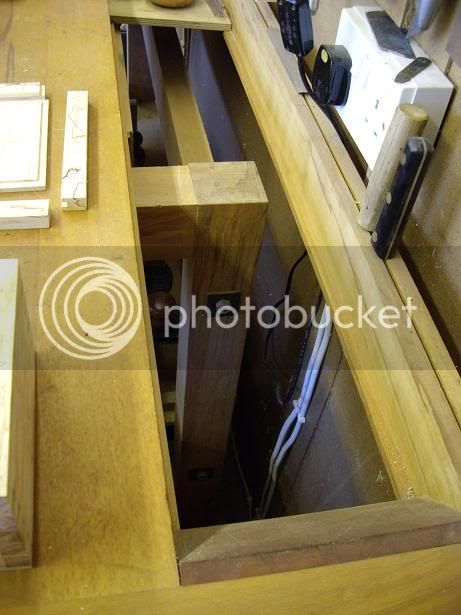Why do traditional workbenches have a tooltray? A necessary feature to have in able to be able to work with your tools? Or is it perhaps a solution for a cross grain joint that has the advantage of having a place to store your hand tools when they are shortly not used?
This question came up while working on a workbench design. My current workbench has a large rack shelf below, very handy to store a few items. Or what is more likely to be a pile of lots of junk of which you don't now what is in there. Or of which you know must be there but somehow the precise location keeps eluding you. No matter how hard and long you search. But what bothers me even more is that along with tiny corners and space behind heavy kit it is the favourite hide out of dust. Thus spend less effective time in the shop due to the eviction notices you have to write out.
I do not have a real desire to have a tooltray so I designed the new workbench without one. While drawing the aprons and caps I realized that the movement of the worktop was all from the front of the bench to the back. The caps are dovetailed into the apron and 'breadboard' to the top. The end of the caps cannot be fixed to the back of the top. It is a cross grain joint. The top must be able to slide along the caps.
When I add a tooltray to the bench the caps can be fixed to the back of the top. The tooltray will act as the panel in a frame and panel door. When the moisture level rises the workbench top tightens up against the tooltray's bottom, the space of the groove joints will reduce. When the moisture levels drop the tooltray loosens up in the top.
Will I stuck to a tooltray less workbench with cpas that will allow for the top to move? Or will I fit a small tooltray with a removable bottom? Or something else?

This question came up while working on a workbench design. My current workbench has a large rack shelf below, very handy to store a few items. Or what is more likely to be a pile of lots of junk of which you don't now what is in there. Or of which you know must be there but somehow the precise location keeps eluding you. No matter how hard and long you search. But what bothers me even more is that along with tiny corners and space behind heavy kit it is the favourite hide out of dust. Thus spend less effective time in the shop due to the eviction notices you have to write out.
I do not have a real desire to have a tooltray so I designed the new workbench without one. While drawing the aprons and caps I realized that the movement of the worktop was all from the front of the bench to the back. The caps are dovetailed into the apron and 'breadboard' to the top. The end of the caps cannot be fixed to the back of the top. It is a cross grain joint. The top must be able to slide along the caps.
When I add a tooltray to the bench the caps can be fixed to the back of the top. The tooltray will act as the panel in a frame and panel door. When the moisture level rises the workbench top tightens up against the tooltray's bottom, the space of the groove joints will reduce. When the moisture levels drop the tooltray loosens up in the top.
Will I stuck to a tooltray less workbench with cpas that will allow for the top to move? Or will I fit a small tooltray with a removable bottom? Or something else?







